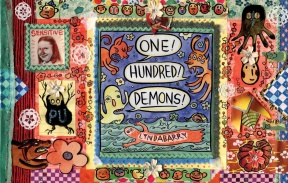Exploding with humour and pathos, “One! Hundred! Demons!” is an eclectic collection of stories, re-published this year by Drawn & Quarterly.

Written and illustrated by Lynda Barry
Lynda Barry’s beloved, genre-defying work of “autobifictionalography” One! Hundred! Demons! exploded the comic book medium, ending up on “Best Of” lists from Time Magazine and the Chicago Tribune. In these seventeen vignettes that touch on the scent of people’s homes, why babies are the best dancers, and how pretentious exboyfriends are like head lice, Barry brings her demons out to be exorcised. Described as “brutally honest, thoughtful and soulful” by Nick Hornby in the New York Times, One! Hundred! Demons! takes on Barry’s childhood with humor and poignancy.
I’d never picked up a Lynda Barry comic before this one, mostly because I’d heard too much about her and I’m stubborn. And in some ways, I got what I expected from this collection – semi-autobiographical tales that semi-bum you out, semi-make you laugh, and visual flair for days. In terms of weight and meaning, though, “One! Hundred! Demons!” goes far beyond the expected.
The concept is an attractive one. Inspired by Hakuin Ekaku, a Zen monk who painted his own demons, Lynda Barry sets out what seems to be the itchiest, most volatile moments of her childhood and beyond. It starts with lice and ends with the Classifieds, and hits diverse topics and moods in between. Throughout, there is no obvious embroidering of the facts – truth and fiction blend seamlessly.
Barry’s art style is a monolith in itself, and difficult to talk about clearly. The cover is overwhelming – a mass of glitter and monsters and flowers and rickrack trim, instantly punching up any surface you lay the book on. With this much concentrated ornament on the outside, the inside feels relatively simple – stories horizontally laid out, done in ink, with clean lines and noodly figures.
The compositions are simplified and flat, usually slapping two figures onto a background and letting them duke it out. This, combined with the horizontal progression of the eye, preserves the feeling of a comic strip. Heads are large, bodies swoop and bend, and characters with glasses have no eyes behind them – a stylization that sometimes pushes the alien aspect of a character.
Barry’s childhood counterpart is rough and expressive, an agglomeration of Band-Aids, freckles, and unruly hair. She often peers up from the corner of a panel, looking skeptical or lost or amazed or, in a few important instances, studiously blank. She always stands out – tangibly awkward, uncomfortably obvious, and watching everything carefully.
Throughout, Barry’s large hand-lettering bounces from panel to panel, shouting narration and dialogue loud and clear. Meanwhile, the warm, bright colours inform even the darkest of moments, giving the collection a unified feel and sometimes hinting at time period.
Originally serialized online, the stories do stand well alone, describing clean arcs that don’t feel artificial. Often, the action pushes a mental change for the worse or better; like in the chapter “Dancing”, where a thoughtless enjoyment of the activity gets pushed and pulled until “the dread and desire were equal”. Others simply follow a theme, like “girlishness”, and where it comes from, as contrasted with tomboyishness. In all cases the demon, the sticky notion at the centre, is apparent and compelling, making it difficult not to think back on your own odd, developmental moments.
An overbearing mother who had a difficult childhood herself is a prominent and recurring figure. She constantly offers criticism – and once, careers into the narrative accompanied by “very intense swearing in Tagalog”. The grandmother, as well as a friendly teacher, act as contrasts, offering moments of calm.
Similarly, issues of race, class and gender appear, ebb, and flow, informing parts of the narrative and running parallel to others. The stories are never “about” any of these, but they’re impossible to ignore – with Barry’s counterpart growing up in a Filipino family in a multicultural neighbourhood in the ’60s.
Finally – and importantly – the supposed resilience of childhood is brought up for question, and neatly demolished. Adapting is not the same thing as forgetting – it may be the opposite – and many of these demons come across like the ghosts of jury-rigged defences.
“One! Hundred! Demons!” is an experience – an affecting one-sitting read that, instead of leaving you bummed out or laughing, according to one note or another, simply trails glowing images behind: romping monsters, rambunctious foster dogs, and neon signs in the rain. It’s various, colourful, and difficult to categorize. And it ends with instructions on how to paint your own demons, because why not? They’re not going anywhere.






